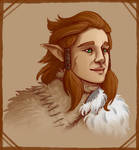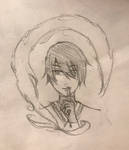Trad Art: Tools of Your Trade Week
Hello everyone, I am happy to be able to post another article as part of projecteducates Traditional art week. Today's painting is inspired by autumn, its coloring and tutorial will present an easy technique, very suitable for beginners and those, that want to just relax and play around with color - in my opinion. I hope you'll enjoy!
____
Let's go over the materials. The list is pretty simple, you'll need a watercolor paper (I prefer 100% cotton paper for this technique, but make your paper at least 300 gsm, so that it can withstand a lot of water and layering), watercolor paints either in tubes or pans, watercolor brush (it should be soft enough and hold enough water), masking tape (important!), paper towels (also important, in watercolor technique paper towel often saves the painting from ending up in trash), water in a jar and a sea sponge. You can try any kind of sponge, but see what kind of texture it creates first, it should be something irregular.

1. Attach the paper to some kind of pad, or to the table with masking tape, make sure all edges stick properly to the surface. If the water with paint gets underneath the tape during painting, your paper will buckle. Mix a very light wash of paint, this will be the base layer. Cover the entire paper with it and let it dry. I used light blue, light purple and light yellow paint for this first layer.
When the base layer dries, mask some tree shapes with masking tape, again make sure that the tape sticks properly. I used the scissors to cut some edges of the tape to get some variation between the shapes. You can also cut the tape in half to get thinner tree shapes.

2. Now that you have all your trees masked, it's time to put down some bright colors. Since you are painting mostly foliage, there is no need to focus on clean and perfect wash of paint, just use a lot of water and let the colors bleed naturally. You can use a bit of table salt to create some bonus texture if you want. Let everything dry properly, before getting rid of the masking tape.
I used Pyrrol red, bright orange, neutral tint for the most part. My paints are Daniel Smith and Schmincke Horadam.


3. You can see that since I used rough paper with high texture, some of the paint bled under my masking tape. At first I thought I will scrap the painting and start over, but then I thought it's natural for birch trees to have some kind of dark imperfections on their trunks and kept on painting.
When you remove the tape, the tree trunks are flat. Grab a smaller, handy brush and add some darker paint around the edges to create shading and an illusion of roundness. With a small brush, paint a few strokes on the trunks. And here is when the fun begins. Grab a sponge, dip it into bright paint (not too thick) and stamp some foliage around the trunks. This is where you can really let your instinct tell you, when to place it, what color it needs to be to achieve balance, and just have fun.

4. Let everything dry and lastly, there is still need to Autumn here and there, I used neutral tint paint again, I like how dark and mysterious this shade is, yet not black and dull. In the end, I decided to experiment and mix media a little, grabbed some colored pencils and added white lines around some trees, a bit of extra texture and details. And I am very happy with the result!


____
VIDEO TUTORIAL:
____































